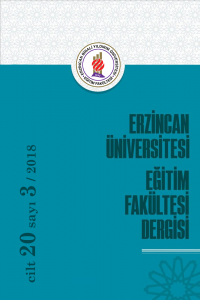Sınıf Öğretmeni Adaylarının Seçme ve Kavrama ile İlgili Problem Kurma Durumlarında Kurdukları Problemlerin İncelenmesi
Abstract
Bu çalışmanın
amacı sınıf öğretmeni adaylarının doğal sayılarla dört işlem ile ilgili
kurdukları problemleri ve problem kurma becerilerini incelemektir. Veriler,
nitel araştırma yaklaşımları arasında yer alan durum çalışması yöntemi
kullanılarak toplanmıştır. İki problem kurma durumundan (Seçme ve Kavrama)
oluşan Problem Kurma Soru Seti (PKSS), Türkiye’de Orta Anadolu’daki bir devlet
üniversitesinde öğrenim gören 72 sınıf öğretmeni adayına uygulanmıştır. Veriler
içerik analizi yaklaşımı ile analiz edilmiştir. Çalışmanın bulgularına göre
öğretmen adaylarının büyük çoğunluğunun kavrama ve seçme problem kurma
durumlarında zorluk yaşamamakta ve ilkokul 4. Sınıf öğrencilerinin seviyesine
uygun sözel problemler kurmaktadırlar. Fakat bazı öğretmen adaylarının
kurdukları problemler kavrama problem kurma durumunda verilen matematiksel
eşitliklere uygun değildir. Benzer şekilde, seçme problem kurma durumunda,
birkaç öğretmen adayı PKSS’de verilen duruma ve cevaba uygun problem
kuramamışlardır. Sınıf öğretmeni adaylarının problem kurma becerilerinin
artırılması için öğretmen adaylarının problem kurma ile ilgili bilgi ve
inançlarının artırılması ve öğretmen yetiştirme programlarında problem kurma
öğretimi yaklaşımının dahil edilmesi gerekmektedir.
References
- Abu-Elwan, R. (1999). The development of mathematical problem posing abilities for prospective middle school teachers. In proceedings of the International conference on Mathematical Education into the 21st Century: Social challenges, Issues and approaches (Vol. 2, pp. 1-8).
- Abu-Elwan, R. (2002). Effectiveness of problem posing strategies on prospective teachers’ problem solving performance. Journal of Science and Mathematics Education in SE Asia, 1, 56-69.
- Altun , M. (2001). Matematik Öğretimi. Bursa: Erkam Matbaacılık.
- Bayazit, İ., & Kırnap-Dönmez, S. M. (2017). Öğretmen adaylarının problem kurma becerilerinin orantısal akıl yürütme gerektiren durumlar bağlamında incelenmesi. Turkish Journal of Computer and Mathematics Education, 8(1), 130-160.
- Chapman, O. (2012). Prospective elementary school teachers’ ways of making sense of mathematical problem posing, PNA, 6(4), 135 – 146.
- Crespo, S. & Sinclair, N. (2008). What makes a problem mathematically interesting? Inviting prospective teachers to pose better problems. Journal of Mathematics Teacher Education, 11, 395-415. doi: 10.1007/s10857-008-9081-0.
- Christou, C., Mousoulides, N., Pittalis, M., Pitta-Pantazi, D., & Sriraman, B. (2005). An empirical taxonomy of problem posing processes. ZDM, 37(3), 149-158. doi: 10.1007/s11858-005-0004-6
- English, L. D. (1998). Children's problem posing within formal and informal contexts. Journal for Research in Mathematics Education, 29(1) 83-106. Doi: 10.2307/749719.
- Işık, A., Işık, C., & Kar, T. (2011). Matematik öğretmeni adaylarının sözel ve görsel temsillere yönelik kurdukları problemlerin analizi. Pamukkale Üniversitesi Eğitim Fakültesi Dergisi, 30(1), 40-49.
- Işık, C., Kar, T., Yalçın, T., & Zehir, K. (2011). Prospective teachers’ skills in problem posing with regard to different problem posing models. Procedia-Social and Behavioral Sciences, 15, 485-489.
- Kılıç, Ç. (2013). Prospective primary teachers’ free problem-posing performances in the context of fractions: An example from Turkey. The Asia-Pacific Education Researcher, 22(4), 677-686. doi: 10.1007/s40299-013-0073-1.
- Korkmaz, E., & Gür, H. (2006). Determining of prospective teachers’ problem posing abilities. Balıkesir Üniversitesi Fen Bilimleri Enstitüsü Dergisi, 8(1), 64–74.
- Lavy, I., & Bershadsky, I. (2003). Problem posing via “what if not?” strategy in solid geometry—a case study. The Journal of Mathematical Behavior, 22(4), 369-387.
- Merriam, S. B. (1998). Qualitative research and case study applications in education. Revised and expanded from case study research in education.. San Francisco: Jossey-Bass Publishers.
- Miles, M.B. & Huberman, A.M. (1994). Qualitative data analysis: An expanded sourcebook (2nd ed.). Thousand Oaks, California: SAGE. doi: 10.1016/S1098-2140(99)80125-8
- Milli Eğitim Bakanlığı [MEB]. (2009). İlköğretim matematik dersi 1–5. sınıflar öğretim programı. Ankara, Türkiye: MEB.
- Milli Eğitim Bakanlığı [MEB]. (2018). Matematik dersi öğretim programı (İlkokul ve Ortaokul 1, 2, 3, 4, 5, 6, 7 ve 8. sınıflar). Ankara, Türkiye: MEB.
- National Council of Teachers of Mathematics [NCTM]. (2000). Principles and standards for school mathematics. Reston, VA.
- Rizvi, N. F. (2004). Prospective teachers’ ability to pose word problems. International Journal for Mathematics Teaching and Learning, 12, 1–22.
- Silver, E. A., & Cai, J. (1996). An analysis of arithmetic problem posing by middle school students. Journal for Research in Mathematics Education, 521-539. doi: 10.2307/749846
- Stoyanova, E., & Ellerton, N. F. (1996). A framework for research into students’ problem posing in school mathematics. In P. C. Clarkson (Ed.), Technology in mathematics education (pp. 518-525). Melbourne, Victoria: Mathematics Education Research Group of Australasia.
- Strauss, A., &Corbin, J. M. (1990). Basics of qualitative research: Grounded theory procedures and techniques. Thousand Oaks: Sage.
- Tichá, M. & Hošpesová, A. (2009). Problem posing and development of pedagogical content knowledge in prospective teacher training. In meeting of CERME Vol. 6, pp. 1941-1950.. doi: 10.1007/978-1-4614-6258-3_21.
- Toluk-Uçar, Z. (2009). Developing pre-service teachers understanding of fractions through problem posing. Teaching and Teacher Education, 25(1), 166-175.
- Törner, G., Schoenfeld, A. H., & Reiss, K. M. (2007). Problem solving around the world: Summing up the state of the art. ZDM, 39(5), 353-353.
- Türnüklü, E., Aydoğdu, M. Z., & Ergin, A. S. (2017). 8. sınıf öğrencilerinin üçgenler konusunda problem kurma çalışmalarının incelenmesi. Bayburt Eğitim Fakültesi Dergisi, 12(24), 467-486.
Details
| Primary Language | Turkish |
|---|---|
| Journal Section | In This Issue |
| Authors | |
| Publication Date | December 21, 2018 |
| Acceptance Date | November 21, 2018 |
| Published in Issue | Year 2018 Volume: 20 Issue: 3 |

